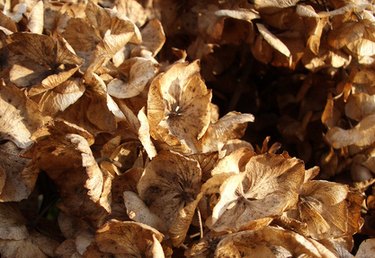Things You'll Need
Shovel
Soil
Garden fork

Amending your garden beds becomes expensive if you depend on purchased compost to add drainage and organic matter to the garden. Instead, reuse your yard and garden waste to create your own compost soil for the garden. Composting takes the organic waste from your yard, such as leaves and grass clippings, along with vegetable waste from the kitchen, and turns it into a soil amendment that is rich in nutrients for your garden plants. Composting isn't difficult, and starting a pile now ensures that you'll have plenty of compost ready come next gardening season.
Step 1
Lay down a 3-to-4-inch layer of chopped up twigs or other coarse material over 4-by-4-foot area, or larger. This layer provides air circulation beneath the compost pile.
Video of the Day
Step 2
Place a 6-inch layer of dead leaves or dead plant material on top of the twigs. Top this with a 2-inch layer of grass clippings or green yard waste. The dead leaves provide carbon to the pile, while the green waste provides nitrogen. Both are necessary for successful composting.
Step 3
Place a shovel-full of garden soil on top the pile to provide natural microorganisms to the pile, which jump-starts the composting process. Alternately, use a purchased compost starter.
Step 4
Mix the layers together with a garden fork, and then water the pile until it is as damp as a wrung out sponge. Add more layers as necessary until the pile is between 3 and 4 feet high, mixing and watering as you go.
Step 5
Scoop out a depression in the center top of the pile. This collects rain water, which ensures that the pile remains damp and ensures even composting.
Step 6
Turn the pile every four weeks with a garden fork. Turn the outside of the pile to the inside and over the materials on the inside.
Step 7
Use the compost once all the material in the pile is broken down and resembles a rich, dark soil. This takes approximately three to six months if you turn the pile monthly.
Tip
Turn the pile as often as once a week. More frequent turning helps the compost mature more quickly.
While not necessary, a compost holding unit helps control the pile so it doesn't spread over too large an area.
Add fruit and vegetable scraps, coffee grounds and crushed egg shells as they accumulate.
Warning
Do not put meat, dairy or greasy items in the compost pile. These break down slowly and attract pests.
Video of the Day